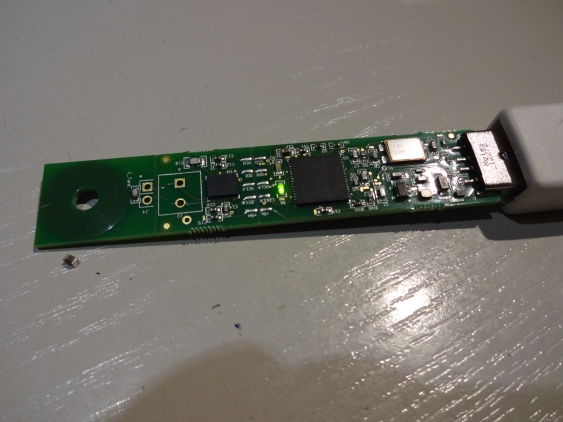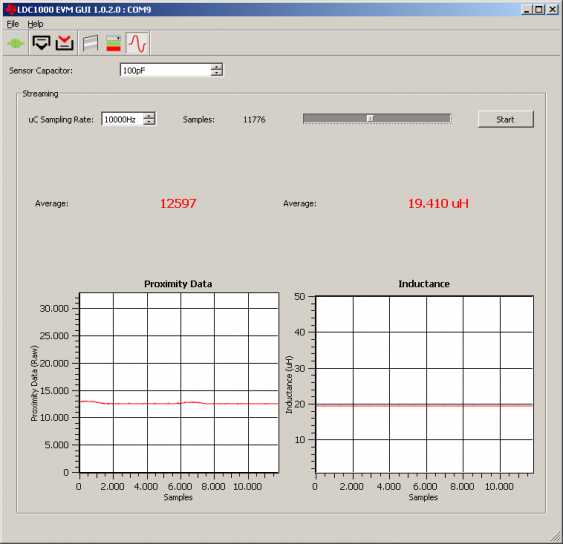Some experiments with the LDC1000 inductive sensor
Texas Instruments recently released their new LCD1000 inductive sensor. They touted it as a “game changing” announcement. And even though I don’t share that excitement, it looks like an interesting sensor (and I don’t work on stuff which relies heavily on position sensing like e.g. the automotive industries). So I ordered the evaluation kit to play a little bit.
In contrast to other orders TI didn’t ship with Fedex this time, so instead of the usual 2 days it took 4 days for the package to arrive. The box they shipped it in was a little bit on the large side for such a small EVM, though.
Tool installation
TI didn’t send a CD with the EVM, and even skips on any documentation leaflet (there is just a generic one pointing to the TI website ). So one needs to go to their website, and find the right place to download the needed software. But installing it went without problems, and the sensor gets detected right away.
The GUI starts directly with showing the measured sensor value (the resonance impedance Rp). So the first involved showing how it reacts to what I had laying around on my desk. Naturally, hovering the coil above anything metallic (e.g. a screwdriver) yields large changes. But even just putting my hand (or a finger) above it shows substantial changes in the measured values.
First tests
To make the sensor more sensitive, the measurement range can be configured. For that, the GUI allows setting the minimum and maximum values of the sensor range (Rpmin and Rpmax). So I set a narrower range, and tried to get the sensor to detect rather minute changes - just to see how sensitive it is in reality (TI demoed already micrometer resolution…)
Under the carpet in my study there are wooden planks nailed onto the floor beams. So I set out to see whether the LDC1000 can detect where the nails are. I can see where the beams are located even under the carpet (because the planks are curved upwards there), but the nails are hidden. I set the Rp range rather narrow, and started searching. With that, one needs to be careful not to change any other conditions around the sensor, like the position of my own hand. But any objects the sensor locates can be seen in the GUI as bends in the plotted values, and because I swiped it shows up as small (or large) spikes, depending on the object found.
And some more
I thought I found the nails rather fast (the LDC1000 has a build-in comparator, and it got triggered, shown by the green LED on the sensor board), but the first two spikes I saw were due to some SMD components (0805 capacitors) hidden in the carpet. (They got lost during a previous rework session).
The small cap on the left side is enough to trigger the LDC1000, provided the configuration is sensitive enough. I simulated this on my bench, because the caps would not show up on the picture if they were still on the carpet (they were lost for a reason…)
After I picked them up (and made sure there was nothing else laying around) the nails got visible in the sensor plot:
The spikes aren’t so much articulated in the plot, they are more like small dents in the value plot. I would need to further increase the sensitivity (by reducing the resonance range) to make it more useful. But since the LDC1000 is intended only for small sensor ranges (several millimeters) it is already astonishing that it could detect such small objects over this distance. It won’t be useful as general purpose metal detector - maybe TI will follow up with something like that.
But for small-range measurements and detection the precision is astonishing. Given its fast sample-rate of up to 100ksps it might even detect vibrations of the object-under-surveillance. So maybe we will see pick-ups for guitar strings, or burglar alarms (detecting any movements on the windows). I for myself want to use it as sensor for rotational speeds (to build a speed controller). It seems to be the easiest and non-invasive way to get this data.
And btw: if you have a better idea of what to do with this sensor, maybe you can enter TI’s inductive sensor design challenge and win…
Update: look at the feedback I got from TI…

